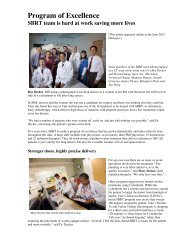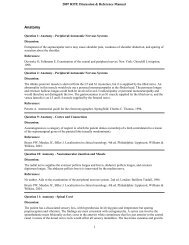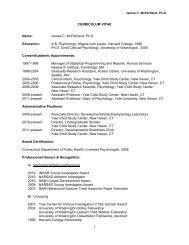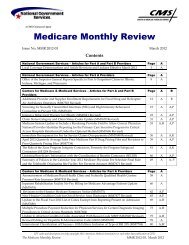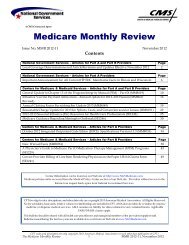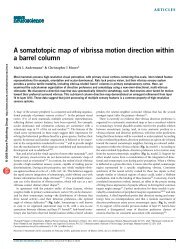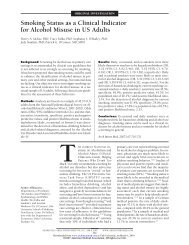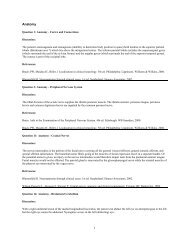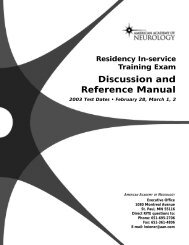HLA and Disease - Yale School of Medicine - Yale University
HLA and Disease - Yale School of Medicine - Yale University
HLA and Disease - Yale School of Medicine - Yale University
You also want an ePaper? Increase the reach of your titles
YUMPU automatically turns print PDFs into web optimized ePapers that Google loves.
<strong>HLA</strong> <strong>and</strong> <strong>Disease</strong><br />
EDITED BY<br />
Jean Dausset<br />
Institut de recherches sur les maladies du sang,<br />
Hôpital Saint-Louis, 2 Paris X e<br />
Arne Svejgaard<br />
Tissue Typing Laboratory <strong>of</strong> the Blood Grouping Department,<br />
State <strong>University</strong> Hospital <strong>of</strong> Copenhagen<br />
Munksgaard<br />
Copenhagen<br />
North <strong>and</strong> South America:<br />
Williams & Wilkins Co.<br />
Baltimore
Genetic Analysis <strong>of</strong><br />
<strong>HLA</strong>-Associated <strong>Disease</strong>s:<br />
The »Illness Susceptible«<br />
Gene Frequency <strong>and</strong><br />
Sex Ratio in<br />
Ankylosing Spondylitis<br />
K. K. Kidd 1 , D. Bernoco 2 , A. O. Carbonara 3 , V. Daneo 4 ,<br />
U. Steiger 5 & R. Ceppellini 2<br />
Introduction<br />
<strong>Disease</strong>s which show familial<br />
concentration but do not show simple<br />
Mendelian patterns are difficult to describe<br />
unambiguously in genetic terms (Kidd &<br />
Cavalli-Sforza (1), Kidd & Spence (2)). In<br />
fact, familial concentration is not even<br />
pro<strong>of</strong> that genetic factors are relevant to<br />
the disease. On the other h<strong>and</strong>, provided<br />
that one is willing to consider population<br />
stratification to be a genetic (albeit<br />
population genetic/social) phenomenon, a<br />
population study can provide evidence for<br />
a genetic component. A significant<br />
association <strong>of</strong> any disease with a good<br />
genetic marker, such as an <strong>HLA</strong> antigen, is<br />
per se evidence that a genetic element<br />
exists in the etiopathogenesis <strong>of</strong> that<br />
1<br />
) Department <strong>of</strong> Human Genetics, <strong>Yale</strong><br />
<strong>University</strong> <strong>School</strong> <strong>of</strong> <strong>Medicine</strong>,<br />
Connecticut, U.S.A.<br />
2<br />
) Basel Institute for Immunology, Basel,<br />
Switzerl<strong>and</strong>.<br />
3<br />
) Istituto di Genetica Medica, Torino, Italy.<br />
4<br />
) Centro di Reumatologia, Ospedale S.<br />
Giovanni Battista, Torino, Italy.<br />
5<br />
) Rheumatology Department, <strong>University</strong><br />
Clinics <strong>of</strong> Basel, Basel, Switzerl<strong>and</strong>.<br />
72<br />
disease. However, unless the marker itself<br />
is clearly <strong>of</strong> etiologic significance, the<br />
interpretation <strong>of</strong> the association in genetic<br />
terms will not be clear. With <strong>HLA</strong><br />
associated diseases both <strong>of</strong> the above<br />
complications exist; diseases being studied<br />
usually do not show simple Mendelian<br />
patterns <strong>and</strong> there are, at present, no<br />
known pathological alleles at the <strong>HLA</strong> loci<br />
(with the single exception <strong>of</strong> the C2 <strong>and</strong><br />
C4 amorph mutants (3, 4) that can explain<br />
the significant, but not complete,<br />
association <strong>of</strong> the illness with particular<br />
allele <strong>and</strong>/or haplotypes. Since <strong>HLA</strong><br />
markers (antigens) are co dominant traits<br />
with full penetrance for their serological<br />
expression, several reasons for the<br />
incomplete association <strong>of</strong> the disease with<br />
the antigen can be given. One explanation<br />
is linkage to (or hitchhiking within) the<br />
<strong>HLA</strong> region <strong>of</strong> a gene directly responsible<br />
for the disease (that is, an “Illness<br />
susceptibility” allele, hereafter abbreviated<br />
to Is). At the moment the best c<strong>and</strong>idates<br />
may be the hypothesized Ir (immune<br />
response) genes, but other possible
polymorphisms, such as hormone<br />
receptors, should also be considered (5). A<br />
second explanation is epistasis, as in the<br />
typical case <strong>of</strong> antigen Lewis b (6).<br />
Ragweed pollen allergy is possibly due to<br />
epistasis between the ability to recognize a<br />
pollen determinant, due to an <strong>HLA</strong> linked<br />
Ir gene, <strong>and</strong> the high level phenotype for<br />
IgE (7-10), although conflicting evidence<br />
exists (11, 12). Another explanation, not<br />
necessarily in contrast with the others, is<br />
“incomplete penetrance” (lack <strong>of</strong> the<br />
phenotype expression expected for a given<br />
genotype) <strong>of</strong> the <strong>HLA</strong> antigen allele in<br />
regard to illness susceptibility (if directly<br />
responsible) or <strong>of</strong> the linked Is allele.<br />
Because the diseases that are being<br />
considered are already known to show no<br />
simple Mendelian pattern, incomplete<br />
penetrance in some form is a likely <strong>and</strong><br />
almost necessary component in any genetic<br />
explanation. Such incomplete entrance<br />
may be caused by a variety <strong>of</strong> factors, both<br />
genetic <strong>and</strong> environmental. On the genetic<br />
side, besides the simplest case mentioned<br />
above <strong>of</strong> epistatic interaction with a single<br />
major locus, polygenic inheritance, with<br />
only one <strong>of</strong> the many loci linked to the<br />
<strong>HLA</strong> system, is another purely genetic<br />
situation. Environmental explanations<br />
would include, for instance, a triggering<br />
infectious disease <strong>and</strong> also some “familial”<br />
factors, such as cohabitation with relatives<br />
sharing not only a similar genotype but<br />
also similar conditions <strong>of</strong> housing <strong>and</strong><br />
habits <strong>of</strong> living.<br />
Existence <strong>of</strong> environmental variation<br />
dilutes out the degree to which genetic<br />
factors determine the variation in the<br />
population for presence or absence <strong>of</strong> a<br />
trait or illness. The relative amount <strong>of</strong><br />
genetic variation is frequently expressed as<br />
heritability (h 2 ), the ratio <strong>of</strong> the genetic<br />
variance in the population to the total<br />
variance for the trait. The authors feel that<br />
heritability ignores some typical <strong>and</strong> most<br />
interesting features <strong>of</strong> human genetics, for<br />
example, possible modes <strong>of</strong> gene action<br />
<strong>and</strong> the difficult distinction between<br />
biological <strong>and</strong> cultural inheritance. Thus,<br />
when applied to human diseases,<br />
heritability is <strong>of</strong>ten a misnomer. Therefore,<br />
the authors will not use it. A more detailed<br />
discussion <strong>of</strong> the inappropriateness <strong>of</strong><br />
heritability in human genetics is given in<br />
Matthysse & Kidd (13).<br />
Family data on diseases are rarely not<br />
insufficient to be informative; population<br />
association data <strong>of</strong> a disease <strong>and</strong> a marker<br />
locus are <strong>of</strong>ten not readily interpretable in<br />
genetic terms. The authors wish to show<br />
that family data on both a disease <strong>and</strong> an<br />
associated (<strong>HLA</strong>) marker can be used to<br />
gain a clearer underst<strong>and</strong>ing <strong>of</strong> the genetics<br />
TABLE I<br />
Criteria followed in Basel <strong>and</strong> Torino for<br />
diagnosis <strong>of</strong> Ankylosing Spondylitis l<br />
Subjective <strong>and</strong> functional<br />
(a) limitation <strong>of</strong> motion <strong>of</strong> lumbar spine 2<br />
(b) history <strong>of</strong> persistent pain<br />
(c) chest expansion < 3 cm (measured at<br />
fourth intercostal space)<br />
X-ray grading (each side graded separately)<br />
0: normal<br />
1: doubtful changes<br />
2: minimal definite change<br />
3: moderate or advanced sacroiliitis with<br />
erosion, evidence <strong>of</strong> sclerosis, widening,<br />
narrowing or partial ankylosis<br />
4: total ankylosing<br />
Definite AS: grade 3-4 X ray, bilateral, plus<br />
at least one clinical sign; grade 3-4<br />
unilateral or grade 2 bilateral plus a+c or<br />
b+c<br />
Probable AS: grade 3-4 bilateral in absence<br />
<strong>of</strong> any clinical sign<br />
To maximize penetrance: all individuals ≤20<br />
years <strong>of</strong> age were excluded<br />
To maximize homogeneity: all cases with<br />
complications were excluded<br />
1) As recommended by G<strong>of</strong>ton et al (18)<br />
2) As recommended by Macrae & Wright (19)<br />
73
<strong>of</strong> the disease. Ankylosing spondylitis<br />
(AS) is a paradigmatic model because AS<br />
is the disease that shows the highest<br />
relative risk with an <strong>HLA</strong> antigen (14, 15).<br />
Family data have been collected in Torino<br />
(TO) (16) <strong>and</strong> Basel (BS) (17) on 53 index<br />
or primary cases who had at least one first<br />
degree relative that could be examined as<br />
completely as the prob<strong>and</strong>, according to a<br />
rigid application <strong>of</strong> the criteria in Table 1<br />
(18, 19). Two groups <strong>of</strong> normal controls<br />
were also examined with the same<br />
diagnostic criteria: (a) a selected sample <strong>of</strong><br />
Results <strong>and</strong> Discussion<br />
The diagnostic criteria listed in Table I<br />
were followed in both the Basel <strong>and</strong><br />
Torino studies. Table 11 presents the data<br />
for the primary cases (prob<strong>and</strong>s) <strong>and</strong><br />
population controls. A preponderance <strong>of</strong><br />
males among ankylosing spondylitis<br />
patients is found, as has been reported in<br />
other studies. The preponderance <strong>of</strong> males<br />
in the normal control populations reflects<br />
the male preponderance among employees<br />
<strong>of</strong> H<strong>of</strong>fman LaRoche in Basel <strong>and</strong> in the<br />
blood donor panel in Torino. These<br />
controls give the B27¬antigen frequency in<br />
the population. Through some difference<br />
exists between Basel <strong>and</strong> Torino, the<br />
increased frequency <strong>of</strong> B27 among AS<br />
patients is spectacular <strong>and</strong> highly<br />
74<br />
B27¬positive individuals who had not<br />
reported subjective symptoms nor had<br />
been in any way aware <strong>of</strong> being affected<br />
by AS; <strong>and</strong> (b) a selected sample <strong>of</strong> B27<br />
negative individuals, mostly chosen for<br />
being B7 positive because <strong>of</strong> the well<br />
known crossreactivity between these two B<br />
antigens. All data in the two studies (BS<br />
<strong>and</strong> TO) were collected without<br />
communication between the<br />
rheumatologists, the <strong>HLA</strong> typists, <strong>and</strong> the<br />
statisticians until the work had been<br />
completed.<br />
significant, as reported in all previous<br />
studies (see 14, 15). From the data on first<br />
degree relatives, presented in Table 111,<br />
the familiality <strong>of</strong> ankylosing spondylitis is<br />
obvious. The two control populations<br />
included in Table III were examined using<br />
the same diagnostic criteria. These data<br />
confirm the low incidence <strong>of</strong> AS in a non-<br />
B27 population <strong>and</strong> the high frequency <strong>of</strong><br />
affected individuals (7 out <strong>of</strong> 43 = 16 %)<br />
among the “normal” B27 positive controls,<br />
using a more rigorous diagnostic<br />
examination than in the report by Calin &<br />
Fries (20). Only one <strong>of</strong> the affected first<br />
degree relatives, a mother, did not have<br />
B27; however, in that family the prob<strong>and</strong>'s<br />
Is B27 haplotype came from the father,<br />
TABLE II<br />
Number studied, sex, <strong>and</strong> B27 phenotype frequency in patients (primary cases) <strong>and</strong> controls<br />
studied in Basel (BS) <strong>and</strong> Torino (TO)<br />
Number Sex<br />
B27<br />
studied M F Class Area frequency<br />
58 48 10 AS patients BS 0.93<br />
623 459 164 Normal controls l BS 0.100<br />
21 20 1 AS patients TO 0.90<br />
1428 980 448 Normal controls 2 TO 0.043<br />
1<br />
) r<strong>and</strong>om employees <strong>of</strong> H<strong>of</strong>fman La Roche<br />
2 ) r<strong>and</strong>om blood donors
who was also AS affected. Also worth<br />
noting is that one affected individual (B7+)<br />
was found among the non B27 controls.<br />
Thus, to the best diagnostic criteria<br />
accepted today, ankylosing spondylitis can<br />
occur, albeit rarely, in the absence <strong>of</strong> the<br />
antigen B27.<br />
TABLE III<br />
Familiality <strong>of</strong> Ankylosing Spondylitis<br />
Primary case First-Degree<br />
Relatives<br />
Normal Affected<br />
Area No. Type Type No. B27 + B27– B27+ B27–<br />
BS 7 Parent Child 13 4 7 2 0<br />
BS 15 Sib Sib 32 13 13 6 0<br />
BS 18 Child Parent 27 10 9 8 0<br />
BS All 72 27 29 16 0<br />
TO 3 Parent Child 5 4 1 0 0<br />
TO 11 Sib Sib 15 6 4 5 0<br />
TO 9 Child Parent 16 6 7 2 1<br />
TO All 36 16 12 7 1<br />
BS + TO combined All 108 43 41 23 1<br />
BS 147 Non-B27 controls - 146 – 1<br />
BS 43 “Normal” B27 controls 36 - 7 –<br />
Tables IV <strong>and</strong> V show that the<br />
preponderance <strong>of</strong> affected males among<br />
prob<strong>and</strong>s neither occurs among the<br />
“normal” B27 + controls nor among the<br />
first degree relatives; Calin & Fries (20)<br />
also found essentially equal frequencies <strong>of</strong><br />
affected males <strong>and</strong> females in their study.<br />
TABLE IV<br />
Frequency <strong>of</strong> Females (ff) in Ankylosing Spondylitis<br />
Class <strong>of</strong><br />
Number<br />
Area<br />
Data Total Males Females ff<br />
BS Primary cases 58 48 10 0.17<br />
BS Secondary cases 72 8/33 1 8/39 1 0.46 2<br />
BS “Normal” B27+ 43 5/34 1 2/9 1 0.60 2<br />
TO Primary cases 21 20 1 0.05<br />
TO Secondary cases 36 4/19 1 4/17 1 0.53 2<br />
1 Ratio <strong>of</strong> number affected by AS to total number studied<br />
2 ff corrected for a 1:1 sex ratio in sample<br />
TABLE V<br />
Frequency <strong>of</strong> Affected Relatives according to Sex l<br />
Primary Cases<br />
Males Females<br />
(n = 33) (n = 8)<br />
All First-degree Males 9/41 = 0.22 ± 0.06 3/11 = 0.27 ± 0.13<br />
relatives Females 11/42 = 0.26 ± 0.07 1/14 = 0.07 ± 0.07<br />
1 Values given as number affected/total = mean ± st<strong>and</strong>ard error<br />
x 2 (3 d. f.) = 2.3 g P = 0.50<br />
75
The family data also show that AS is as<br />
frequent, within the statistical limits <strong>of</strong> the<br />
small sample, among the relatives <strong>of</strong><br />
female prob<strong>and</strong>s as <strong>of</strong> male prob<strong>and</strong>s,<br />
suggesting that there is no “hereditary”<br />
component to any hypothesized sex<br />
limitation or greater male susceptibility.<br />
An obvious conclusion is that the male<br />
preponderance among AS patients is not a<br />
reflection <strong>of</strong> a truly greater incidence<br />
among males. Possible explanations for<br />
this could be greater severity in males, a<br />
greater tendency for the diagnosis to be<br />
made in males, <strong>and</strong> a greater tendency for<br />
males to seek treatment. Whatever the<br />
explanation, the “fact” that males are more<br />
frequently affected with AS than females is<br />
probably not true in an absolute sense.<br />
Genetic Analyses<br />
Analyses <strong>of</strong> family data normally involve<br />
testing the goodness <strong>of</strong> fit <strong>of</strong> different<br />
genetic hypotheses (models) to the<br />
observed data. The two models most<br />
commonly used in human genetics are the<br />
simple extremes <strong>of</strong> single major locus<br />
(SML) <strong>and</strong> multifactorial polygenic (MF)<br />
inheritance (see Matthysse & Kidd (12) for<br />
a review <strong>of</strong> these two models). One major<br />
problem with these models is that they are<br />
statistically indistinguishable <strong>and</strong><br />
agreement cannot be tested when family<br />
incidence data are used without additional<br />
sources <strong>of</strong> genetic information (1, 21).<br />
Nonetheless, both models have been<br />
applied to the AS family data to see<br />
whether the results would be biologically<br />
reasonable.<br />
The single parameter <strong>of</strong> the MF model<br />
needing estimation is the genetic<br />
correlation among relatives. This<br />
correlation is <strong>of</strong>ten translated into an<br />
heritability (h2) value; however, the<br />
correlation or heritability does not apply to<br />
the measured trait, in this case ankylosing<br />
76<br />
spondylitis, but to a hypothetical<br />
underlying continuous <strong>and</strong> normally<br />
distributed variable called “liability to<br />
disease”. The general incidence <strong>of</strong> the<br />
illness <strong>and</strong> the frequency <strong>of</strong> affected firstdegree<br />
relatives are the necessary data for<br />
estimating the correlation. The generally<br />
accepted population prevalence for AS is<br />
about 0.5 % for males <strong>and</strong> considerably<br />
less for females. The average incidence<br />
among first degree relatives is 0.22 ± 0.04.<br />
These values give an estimate <strong>of</strong> the<br />
tetrachoric correlation (1) <strong>of</strong> about 0.65, a<br />
nonsensical result according to the MF<br />
model, for which the theoretical maximum<br />
is 0.50, i.e. h2 == 100 %. However, the<br />
general incidence estimate is based on the<br />
frequency <strong>of</strong> patients seeking treatment<br />
<strong>and</strong> not upon a complete diagnostic survey<br />
<strong>of</strong> the population using both functional<br />
tests <strong>and</strong> X rays. In fact, primary <strong>and</strong><br />
secondary cases are usually ascertained<br />
according to widely different criteria. The<br />
authors' finding that 16 % <strong>of</strong> a sample <strong>of</strong><br />
B27+ individuals were affected suggests<br />
that the population prevalence may be<br />
about 1.5 % for both males <strong>and</strong> females.<br />
Using this value for the incidence in the<br />
population <strong>and</strong> 0.22 for the frequency <strong>of</strong><br />
affected first degree relatives, the<br />
correlation coefficient is lower but still<br />
above 0.50 the heritability (h2) is > 100<br />
%. Such high correlations are <strong>of</strong>ten<br />
interpreted as suggesting that a locus <strong>of</strong><br />
major effect is involved.<br />
Methods for using family data to estimate<br />
the parameters <strong>of</strong> the SML model are<br />
extensively discussed elsewhere (1, 2, 13,<br />
21, 22). To save space the model <strong>and</strong><br />
methods will not be discussed here.<br />
Analyses show that no solution is possible<br />
for an incidence <strong>of</strong> the disease in the<br />
population <strong>of</strong> less than 1.0 %. However,<br />
the closest solution to the data (using the<br />
method <strong>of</strong> Suarez et al. (22)) predicts a<br />
population incidence for AS <strong>of</strong> about
TABLE VI<br />
Genetic Analysis <strong>of</strong> Ankylosing Spondylitis by the Method <strong>of</strong> Thomson & Bodmer (23)<br />
Basic Values:<br />
q = frequency <strong>of</strong> <strong>HLA</strong>-B27 allele (B27) = 0.048<br />
f(M | Ill) = frequency <strong>of</strong> the marker (B27) phenotype among ill (AS) patients =<br />
73/79 = 0.924 ± 0.030<br />
krec. = 1− 1− f(M | Ill) = 0.724<br />
kdom. = (1− (1− f(M | Ill)) /(1− q) = 0.920<br />
Observed genotype distribution in AS patients (primary cases only)<br />
€<br />
€<br />
BS<br />
TO<br />
B27/B27<br />
3<br />
0<br />
B27/–<br />
51<br />
19<br />
–/–<br />
4<br />
2<br />
Total 3 70 6<br />
Expected genotype distributions<br />
Recessive hypothesis 41.5 31.5 6 X 2 1 = 82.5<br />
p
illness among those with the susceptibility<br />
allele. Utilizing whichever model fits the<br />
data, it is then possible to estimate all four<br />
haplotype frequencies. Though more exact<br />
treatments are possible, the low<br />
frequencies <strong>of</strong> the marker allele (B27) <strong>and</strong><br />
the illness (AS) allow a simplified<br />
calculation for the dominant model, as<br />
outlined in Table VII. The estimates for the<br />
penetrance <strong>and</strong> the haplotype frequencies<br />
agree well with the SML solution obtained<br />
without consideration <strong>of</strong> the <strong>HLA</strong><br />
association.<br />
Some caveats about the penetrance<br />
estimate are very important in evaluating<br />
these results. It is impossible to generalize<br />
from this penetrance estimate to families<br />
not ascertained through a prob<strong>and</strong>. The<br />
value <strong>of</strong> 0.38 is not significantly less than<br />
0.5, the approximate value expected in<br />
families if an allele at an independent locus<br />
were also required for development <strong>of</strong> the<br />
illness. Prob<strong>and</strong>s, being affected, would be<br />
carriers for both alleles; because <strong>of</strong><br />
independent segregation, only about half <strong>of</strong><br />
the first-degree relatives with the Is allele<br />
at the main locus would also have the<br />
necessary allele at the second. Thus, the<br />
family estimate <strong>of</strong> penetrance will be an<br />
78<br />
overestimate for an unrelated group <strong>of</strong><br />
individuals. The accuracy <strong>of</strong> the estimate<br />
depends on the degree <strong>of</strong> epistasis <strong>and</strong>, if<br />
epistasis exists, on the frequencies <strong>of</strong> the<br />
interacting alleles.<br />
Another caveat about the family<br />
estimate <strong>of</strong> penetrance is that it includes<br />
recombination that separates the marker<br />
from the susceptibility allele.<br />
Even an exact calculation <strong>of</strong> the<br />
penetrance from family data would include<br />
corrections for the age <strong>of</strong> onset distribution<br />
(only roughly done in this study by<br />
limiting consideration to adult relatives)<br />
<strong>and</strong> for the probability <strong>of</strong> ascertainment,<br />
which is determined by the number <strong>of</strong><br />
affected individuals in a family. In spite <strong>of</strong><br />
these potential biasses, not all <strong>of</strong> which<br />
operate in the same direction, the<br />
penetrance estimate is roughly consistent<br />
with the population <strong>and</strong> control data. From<br />
what is known about AS, it is very unlikely<br />
to be as high as 100 %, <strong>and</strong> the “normal”<br />
B27+ control data show that it cannot be<br />
below 16 %.<br />
The estimated frequency <strong>of</strong> the<br />
haplotype m Is is too low (0.002) to<br />
explain the 4 % <strong>of</strong> AS patients who lack<br />
the B27 marker, even if the “penetrance”<br />
TABLE VII<br />
Summary <strong>of</strong> a simplified Bayesian probability analysis for Ankylosing Spondylitis<br />
M = marker allele for B27 antigen; frequency <strong>of</strong> M = 0.048 ± 0.01<br />
I = allele for illness susceptibility<br />
A. observed frequency <strong>of</strong> M among AS patients = 0.92 ± 0.03 = Pr (M|I) = Pr (M|AS)<br />
B. observed frequency <strong>of</strong> AS among M + (B27 +) population = 0.16 ± 0.06 = Pr (AS|M)<br />
C. observed frequency <strong>of</strong> AS among M+ (B27+)<br />
first degree relatives <strong>of</strong> prob<strong>and</strong>s = “penetrance” = 0.38 + 0.06 = Pr (AS|I)<br />
Therefore, Pr(I|M) = 0.16/0.38 = 0.42<br />
<strong>and</strong> Pr(I) = Pr (I|M) • Pr (M) /Pr (M|I) = 0.022<br />
It follows that:<br />
x1 = freq. (MI haplotype) = Pr (I|M) • Pr (M) = 0.020<br />
x2 = freq. (Mi) = Pr(M) – x1 = 0.028<br />
x3 = freq. (mI) = Pr(I) – x1 = 0.002<br />
x4 = freq. (mi) = 1 – x1 – x2 – x3 = 0.950<br />
Δ = x1x4 – x2x3 = 0.019
for that haplotype were 100 %. Sampling<br />
error in the estimate <strong>of</strong> the penetrance or in<br />
the frequency <strong>of</strong> affected individuals who<br />
are B27 negative might have produced this<br />
Conclusions<br />
Though mathematical genetics has many<br />
limitations when applied to familial traits<br />
that are not obviously Mendelian, it<br />
becomes a powerful tool when a marker<br />
locus can also be studied in those families.<br />
The authors have shown that the <strong>of</strong>t<br />
mentioned preponderance <strong>of</strong> affected<br />
males is found neither in families <strong>of</strong> AS<br />
patients nor in population surveys <strong>and</strong> one<br />
must conclude that the apparent sex<br />
limitation is mainly due to ascertainment.<br />
Susceptibility to AS is inherited as an<br />
autosomal dominant. The locus seems to<br />
be tightly linked to <strong>HLA</strong> B. According to<br />
this model, the susceptibility allele has a<br />
gene frequency <strong>of</strong> about 2 %. Also, it is in<br />
Acknowledgement<br />
The part <strong>of</strong> the work done in Torino was<br />
supported by C.N.R. grant “Centro di<br />
Studio per l'Istocompatibilità a<br />
References<br />
1. Kidd, K. K. & Cavalli Sforza, L. L. (1973)<br />
An analysis <strong>of</strong> the genetics <strong>of</strong><br />
schizophrenia. Soc. Biol. 20, 254-265.<br />
2. Kidd, K. K. & Spence, M. A. (1976) Genetic<br />
analyses <strong>of</strong> pyloric stenosis suggesting a<br />
specific maternal effect. J. med. Genetics<br />
13, 290-294.<br />
3. Agnello, V. M., de Bracco, M. E. & Kunkel,<br />
H. J. (1972) Hereditary C2 deficiency with<br />
some manifestations <strong>of</strong> systemic lupus<br />
erythematosus. J. Immunol. 108, 873-881.<br />
4. Hauptmann, G., Grosshause, E., Heid, E.,<br />
Mayer, S. & Basset, A. (1976) Lupous<br />
érythémateaux aigu avec deficit complet<br />
de la fraction C4 du complément. La<br />
apparent discrepancy. However, the SML<br />
solution discussed earlier predicted about 3<br />
% phenocopies, a value in close<br />
agreement.<br />
strong linkage disequilibrium with the<br />
allele determining <strong>HLA</strong> B27: nearly all<br />
(93 %) <strong>of</strong> the haplotypes with the is allele<br />
also carry the B27 allele. The majority (62<br />
%) <strong>of</strong> the carriers <strong>of</strong> the Is allele do not<br />
develop AS. As repeatedly mentioned, this<br />
incomplete penetrance may be due to<br />
environmental factors or to epistasis with<br />
an allele at an independent locus.<br />
Obviously, this is a formal explanation<br />
with a strong heuristic component. Tests<br />
<strong>of</strong> these conclusions will have to be based<br />
on additional family studies <strong>of</strong> B27<br />
negative AS prob<strong>and</strong>s, <strong>of</strong> female AS<br />
prob<strong>and</strong>s <strong>and</strong> <strong>of</strong> relatives <strong>of</strong> different<br />
degrees.<br />
l'Immunogenetica”. The analyses were<br />
supported in part by N.I.H. grant NS<br />
11786.<br />
Nouv. Presse Méd. 3, 881-885.<br />
5. Ceppellini, R. (1971) Old <strong>and</strong> new facts <strong>and</strong><br />
speculations about transplantation antigens<br />
<strong>of</strong> man. In: Progress in Immunology I, ed.<br />
Amos, D. B., p. 973. Academic Press Inc.,<br />
New York.<br />
6. Ceppellini, R. (1959) Physiological genetics<br />
<strong>of</strong> human blood factors. In: Ciba<br />
Foundation symposium on Biochemistry <strong>of</strong><br />
Human Genetics, eds. Wolstenholme, G.<br />
E. W. & O’Connor, C. M., Churchill,<br />
London.<br />
7. Blumenthal, M. N., Amos, D. B., Noreen,<br />
H., Mendell, N. R. & Yunis, E. J. (1974)<br />
Genetic mapping <strong>of</strong> Ir locus in man:<br />
79
Linkage to second locus <strong>of</strong> HL-A. Science<br />
184, 1301-1303.<br />
8. Levine, B. B., Stember, R. H. & Fotino, M.<br />
(1972) Ragweed bay fever: Genetic<br />
control <strong>and</strong> linkage to HL-A haplotypes.<br />
Science 178, 1201-1203.<br />
9. Marsh, D. G. & Bias, W. B. (1974) Control<br />
<strong>of</strong> specific allergic response in man: HL A<br />
associated <strong>and</strong> IgE regulating genes. Fed.<br />
Proc. 33, 774.<br />
10. Marsh, D. G., Bias, W. B. & Ishizaka, K.<br />
(1974) Genetic control <strong>of</strong> basal serum<br />
immunoglobulin E level <strong>and</strong> its effect on<br />
specific reaginic sensitivity. Proc. nat.<br />
Acad. Sci. (Wash.) 71, 3588-3592.<br />
11. Bias, W B. & Marsh, D. G. (1975) HL-A<br />
linked antigen E immune response genes:<br />
An unproven hypothesis. Science 188,<br />
375-377.<br />
12. Black, P. L., Marsh, D. G., Jarrett, E.,<br />
Delespesse, G. J. & Bias, W. B. (1976)<br />
Family studies <strong>of</strong> association between<br />
<strong>HLA</strong> <strong>and</strong> specific immune responses to<br />
highly purified pollen allergens.<br />
Immunogenetics 3, 349-368.<br />
13. Matthysse, S. W. & Kidd, K. K. (1976)<br />
Estimating the genetic contribution to<br />
schizophrenia. Amer. J. Psychiatry 133,<br />
185-191.<br />
14. Brewerton, D. A., Caffrey, M., Hart, F. D.,<br />
James, D. C. 0., Nicholls, A. & Sturrock,<br />
R. D. (1973) Ankylosing spondylitis <strong>and</strong><br />
HL-A 27. Lancet 301, 904-907.<br />
15. Schlosstein, L., Terasaki, P. I., Bluestone,<br />
R. & Pearson, C. M. (1973) High<br />
association <strong>of</strong> an HL A antigen, W27, with<br />
ankylosing spondylitis. New. Eng. J. Med.<br />
288, 704.<br />
16. Daneco, V., Migone, N., Modeno, V.,<br />
Biancbi, S. D., Alfieri, G., Diotallevi, P.,<br />
Carbona, A. 0. & Piazza, A. (1976) Family<br />
studies <strong>and</strong> <strong>HLA</strong> typing in ankylosing<br />
spondylitis <strong>and</strong> sacroiliitis. J. Rheumatol.,<br />
(in press).<br />
80<br />
17. Truog, P., Steiger, U., Contu, L., Galfre,<br />
G., Trucco, M., Bernoco, D., Bernoco, M.,<br />
Birgen, I., Dolivo, P. & Ceppellini, R.<br />
(1975) Ankylosing spondylitis (AS): A<br />
population <strong>and</strong> family study using HL-A<br />
serology <strong>and</strong> MLR. In: Histocompatibility<br />
Testing 1975, ed. Kissmeyer-Nielsen, F.,<br />
p. 788-796. Munksgaard, Copenhagen.<br />
18 G<strong>of</strong>ton, I. P., Bennett, P. H., Bremmer, I.<br />
M., Bywaters, E. G. L., Calabro, J. I.,<br />
McEwan, C. & Martel, W. (1966)<br />
Population studies <strong>of</strong> rheumatic diseases,<br />
p. 456. Proc. 3rd International<br />
Symposium, New York.<br />
19. Macrae, I. F. & Wright, U. (1969)<br />
Measurement <strong>of</strong> back movement. Ann.<br />
rheum. Dis. 28, 584.<br />
20. Calin, A. & Fries, J. F. (1975) Striking<br />
prevalence <strong>of</strong> ankylosing spondylitis in<br />
“healthy” W27 positive males <strong>and</strong><br />
females. New Eng. J. Med. 293, 835-839.<br />
21. Reich, T., James, J. W. & Morris, C. A.<br />
(1972) The use <strong>of</strong> multiple thresholds in<br />
determining the mode <strong>of</strong> transmission <strong>of</strong><br />
semi continuous traits. Ann. Hum.<br />
Genetics 36, 163-184.<br />
22. Suarez, B. K., Reich, T. & Trost, J. (1976)<br />
Limits <strong>of</strong> the general two allele single<br />
locus model in genetic explanations. Ann.<br />
Hum. Genetics, (in press).<br />
23. Thomson, G. & Bodmer, W. F. (1977) The<br />
genetics <strong>of</strong> <strong>HLA</strong> <strong>and</strong> disease association.<br />
In: Measuring Selection In Natural<br />
Populations, eds. Barndorff-Nielsen, O.,<br />
Christiansen, F. B. & Fenchel, T.<br />
Munksgaard, Copenhagen, (in press).<br />
24. Kidd, K. K. & Ceppellini, R. (1977) A<br />
bayesian method for estimation <strong>of</strong> <strong>HLA</strong>associated<br />
illness susceptibility (Is) allele<br />
frequencies. I. Dominant susceptibility. In:<br />
<strong>HLA</strong> <strong>and</strong> <strong>Disease</strong>, eds. Dausset, J. &<br />
Svejgaard, A., p. 81, Munksgaard,<br />
Copenhagen.
A Bayesian Method for<br />
Estimation <strong>of</strong><br />
<strong>HLA</strong> Associated<br />
Illness Susceptibility (Is)<br />
Allele Frequencies. I.<br />
Dominant Susceptibility<br />
Kenneth K. Kidd 1 & Ruggero Ceppellini 2<br />
Introduction<br />
Thomson & Bodmer (1) present two types<br />
<strong>of</strong> genetic analysis for disease phenotypes<br />
associated with a genetic marker. Their<br />
first method utilizes the marker phenotype<br />
frequency in a population <strong>of</strong> unrelated<br />
affected individuals; the second is derived<br />
from more general models by Day &<br />
Simons (2) <strong>and</strong> utilizes the frequencies <strong>of</strong><br />
the number <strong>of</strong> marker chromosomes<br />
(haplotypes) shared by affected sib pairs.<br />
Both methods involve tests for specific<br />
models <strong>of</strong> inheritance <strong>of</strong> illness<br />
susceptibility (Is) recessive or rare<br />
dominant. Green & Woodrow (3) have<br />
also produced an analysis utilizing<br />
frequencies <strong>of</strong> shared chromosomes among<br />
affected siblings to test the null hypothesis<br />
<strong>of</strong> there being no association between<br />
marker locus <strong>and</strong> illness. None <strong>of</strong> these<br />
papers considers direct estimates <strong>of</strong> the<br />
haplotype frequencies, though Thomson &<br />
1 ) Department <strong>of</strong> Human Genetics, <strong>Yale</strong><br />
<strong>University</strong> <strong>School</strong> <strong>of</strong> <strong>Medicine</strong>,<br />
Connecticut, U.S.A.<br />
2 ) Basel Institute for Immunology, Basel,<br />
Switzerl<strong>and</strong>.<br />
Bodmer (1) consider indirect estimates for<br />
their recessive model applied to data on<br />
pairs <strong>of</strong> affected siblings. Direct estimates<br />
are possible when certain types <strong>of</strong> data are<br />
available: (a) the frequency <strong>of</strong> illness<br />
among individuals with the associated<br />
marker, f(Ill | M); <strong>and</strong> (b) the “penetrance”<br />
or frequency <strong>of</strong> the illness among those<br />
with the susceptibility genotype.<br />
The general importance <strong>of</strong> these types<br />
<strong>of</strong> data, particularly estimating penetrance<br />
from family data, has been recognized in<br />
the design <strong>of</strong> the study <strong>of</strong> ankylosing<br />
spondylitis in Basel <strong>and</strong> Torino<br />
(Ceppellini, personal communication).<br />
Suitable data are consequently already<br />
available for ankylosing spondylitis; they<br />
may soon be collected for other <strong>HLA</strong><br />
associated illnesses. f(Ill | M) can be<br />
collected using the same criteria for<br />
diagnosis as in prob<strong>and</strong>s <strong>and</strong> relatives <strong>and</strong><br />
should be less subject to bias <strong>and</strong><br />
uncertainty than estimates <strong>of</strong> the frequency<br />
<strong>of</strong> the illness in the general population.<br />
The penetrance can be estimated in many<br />
ways, but the simplest <strong>and</strong> most common<br />
is the proportion <strong>of</strong> affected individuals<br />
81
€<br />
among relatives who carry the same<br />
marker chromosome (for the dominant<br />
model) or marker chromosomes (recessive<br />
model) as the prob<strong>and</strong>. These estimates,<br />
combined with the marker allele frequency<br />
<strong>and</strong> the frequency <strong>of</strong> the marker phenotype<br />
among affected individuals, can be used to<br />
Method<br />
A more exact <strong>and</strong> general treatment <strong>of</strong> the<br />
dominant <strong>and</strong> recessive models, utilizing<br />
the additional types <strong>of</strong> data <strong>and</strong><br />
considering more precise estimates <strong>of</strong><br />
penetrance (involving correction for age <strong>of</strong><br />
onset variation <strong>and</strong> for ascertainment<br />
biasses) will be presented elsewhere. Only<br />
the simplified dominant model, as can be<br />
used for ankylosing spondylitis, is<br />
presented here. This approximate analysis<br />
€<br />
is possible whenever both the marker allele<br />
<strong>and</strong> the Is allele have a low frequency in<br />
the population. The general method is<br />
based on the Bayesian probability.<br />
Pr(Is) =<br />
82<br />
Pr(Is | M) • Pr(M)<br />
Pr(M | Is)<br />
, (1)<br />
i.e., that the frequency or probability <strong>of</strong> the<br />
Is genotype is equal to the frequency <strong>of</strong> the<br />
Is genotype among individuals with the<br />
marker phenotype multiplied by the<br />
frequency <strong>of</strong> the marker phenotype, <strong>and</strong><br />
the product divided by the frequency <strong>of</strong> the<br />
marker among affected individuals. This<br />
assumes that illness occurs among some<br />
fraction <strong>of</strong> those carrying the Is genotype<br />
but is otherwise independent <strong>of</strong> the<br />
presence <strong>of</strong> the marker.<br />
The frequency <strong>of</strong> the marker, Pr(M), is<br />
estimated from population surveys<br />
independent <strong>of</strong> studies <strong>of</strong> disease<br />
association. The frequency <strong>of</strong> the marker<br />
among affected persons, Pr(M | Ill) =<br />
Pr(M|Is) = f(M | Ill), is the estimate used to<br />
calculate haplotype frequencies. These<br />
types <strong>of</strong> data should become available<br />
before sufficient pairs <strong>of</strong> affected sibs<br />
have been studied for the other types <strong>of</strong><br />
analysis, especially if the association is<br />
strong <strong>and</strong> illness susceptibility is<br />
dominant.<br />
show association <strong>and</strong> used in the initial<br />
tests <strong>of</strong> Thomson & Bodmer (their<br />
“FAD”). The third quantity in Equation 1,<br />
Pr(Is|M), can be estimated from<br />
Pr(Is | M) =<br />
Pr(Illness | M)<br />
Pr(Illness | Is)<br />
, (2)<br />
i.e., from the frequency <strong>of</strong> illness among<br />
those with the marker, f (Ill | M) divided<br />
by the penetrance. Thus, the frequency <strong>of</strong><br />
the Is genotype is a function <strong>of</strong> estimable<br />
values.<br />
For the dominant model with the<br />
additional simplifying assumption that the<br />
phenotype frequency is twice the allele<br />
frequency, for both the marker <strong>and</strong> Is<br />
allele, Equation I roughly estimates the Is<br />
allele frequency by using the marker allele<br />
frequency for Pr(M). The four haplotype<br />
frequencies are then estimated as follows:<br />
x1= freq. (M Is haplotype) =<br />
Pr(Is|M) • Pr(M)<br />
x2 = freq. (M is haplotype) =<br />
Pr(M) – x1<br />
x3 = freq. (m Is haplotype) =<br />
Pr(Is) – x1<br />
x4 = freq. (m is haplotype) =<br />
1 – x1 – x2 – x3<br />
This simplified form <strong>of</strong> the analysis is<br />
used by Kidd et al. (4) on data in<br />
ankylosing spondylitis. The error, when<br />
compared with a more exact analysis using<br />
the same data, is not detectable to three<br />
decimal places.
Acknowledgement<br />
References<br />
1. Thomson, G. & Bodmer, W. F. (1976)<br />
The genetics <strong>of</strong> <strong>HLA</strong> <strong>and</strong> disease<br />
association. In: Measuring Selection in<br />
Natural Populations, eds. Barndorff-<br />
Nielsen, O., Christiansen, F. B. &<br />
Fenchel, T. Munksgaard, Copenhagen,<br />
(in press).<br />
2. Day, N. E. & Simons, M. J. (1976)<br />
<strong>Disease</strong> susceptibility genes their<br />
identification by multiple case family<br />
studies. Tissue Antigens 8, 109-119.<br />
3. Green, J. R. & Woodrow, J. C. (1976)<br />
Sibling method for detecting <strong>HLA</strong><br />
The work was supported in part by grant<br />
NS 11786 from the N.I.H., U.S. Public<br />
Health Service.<br />
linked genes in disease. (Submitted for<br />
publication.)<br />
4. Kidd, K. K., Bernoco, D., Carbonara,<br />
A.O., Daneo, V, Steiger, U. &<br />
Ceppellini, R.<br />
(1977) Genetic analysis <strong>of</strong> <strong>HLA</strong> associated<br />
diseases: the “illness susceptible” gene<br />
frequency <strong>and</strong> sex ratio in ankylosing<br />
spondylitis. In: <strong>HLA</strong> <strong>and</strong> <strong>Disease</strong>, eds.<br />
Dausset, J. & Svejgaard, A.<br />
Munksgaard, Copenhagen, p. 72.<br />
83




